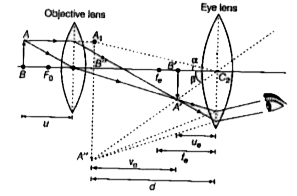Draw the ray diagram for the formation of image by a compound microscope. What is its magnification?
Ray diagram for the formation of image by compound microscope

The magnification produced by the compound produced is the product of the magnification produced by the eyepiece and objective.
Similar Questions
Write the ray diagram for formation of image in the simple microscope.
View SolutionDraw the labelled ray diagram for the formation of image by a compound microscope.
Derive the expression for the total magnification of a compound microscope. Explain why both the objective and the eyepiece of a compound microscope must have short focal lengths.
View Solution(a) Draw a labelled ray diagram showing the formation of a final image by a compound microscope at least distance of distinct vision.
(b) The total magnification produced by a compound microscope is 20. The magnification produced by the piece is 5. The microscope is focussed on a certain object. The distance between the objective and eyepiece is observed to be 14cm. If least distance of distinct vision is 20cm, calculate the focal length of the objective and the eye piece.
View SolutionDraw labelled ray diagram to show image formation in a compound microscope. Write the expression for its magnifying power.
View SolutionDraw ray diagrams showing the image formation by a concave lens when an object is placed
(a) between focus and twice the focal length of the lens
(b) beyond twice the focal length of the lens
View SolutionDraw a ray diagram to show the formation of image by a concave mirror for an object beyond its centre of curvature. State three characteristics of the image.
View Solution(a) Draw a ray diagram showing the image formation by a compound microscope. Hence obtain expression for total magnification when the image is formed at infinity.
View SolutionDraw a ray diagram showing the image formation by a compound microscope. Hence, obtain expression for total magnification when the image is formed at infinity.
View Solution
Draw a ray diagram to show the formation of the image as specified in the part a.
View SolutionDraw a ray diagram to show image formation by a concave lens.
View Solution
